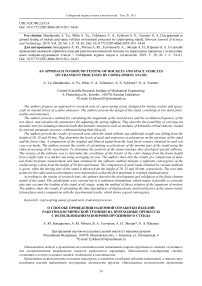An approach to ground testing of rockets and space vehicles on transient processes by copra-spring stand
Автор: Bondarenko A. Yu., Mitin A. Yu., Tolchenov V.A., Eykhorn A.N., Yuranev O.A.
Журнал: Сибирский аэрокосмический журнал @vestnik-sibsau
Рубрика: Авиационная и ракетно-космическая техника
Статья в выпуске: 1 т.20, 2019 года.
Бесплатный доступ
He authors propose an approach to research tests of copra-spring stand, designed for testing rockets and space- craft on inertial forces of a pulse character. The authors present the design of the stand, consisting of two main parts: mobile and stationary. The authors present a method for calculating the magnitude of the load factors and the oscillation frequency of the test object, and calculate the parameters for adjusting the spring stiffness. They describe the possibility of carrying out dynamic tests for imitating transient loads that hermetic structures such as modules of habitable orbital stations, loaded by internal pneumatic pressure, withstand during their lifecycle. The authors present the results of research tests when the stand without any additional weight was falling from the height of 20, 35 and 50 mm. They determine the levels of axial and transverse accelerations on the envelope of the stand and the lower ring. A comparison of the original and filtered signal from the load factor sensors obtained in each test case was made. The authors present the results of calculating accelerations of the moving part of the stand using the video processing of the experiment. To determine the position of the stand envelope they developed special software. The essence of the software was to determine the coordinate of the border of the color change from the frame height from a light color to a darker one using averaging in rows. The authors show that the results of a comparison of man- ual frame-by-frame measurement and data obtained by the software method indicate a sufficient convergence of the results using a drop from the height of 20 mm experiment. The comparison of axial loads obtained by various methods is given, when the moving part of the stand is thrown from the height of 20, 35 and 50 mm, respectively. The zero time points for the video and accelerometers were determined so that the first maximum is reached simultaneously. According to the results of research tests, the authors describe the development and validation of the finite element model of the stand. The calculations were carried out in a nonlinear formulation, which makes it possible to correctly take into account the loading of the stand at all stages, using the method of direct solution of the equations of motion. The authors show the results if calculating the time dependences of displacements and load factors at the sensor instal- lation places and a comparison with the experimental results, which shows a good convergence.
Copra-spring stand, ground tests, transient processes
Короткий адрес: https://sciup.org/148321896
IDR: 148321896 | УДК: 629.786.2.015.4 | DOI: 10.31772/2587-6066-2019-20-1-54-61
Текст научной статьи An approach to ground testing of rockets and space vehicles on transient processes by copra-spring stand
Introduction. As experience confirms the most intensive dynamic loads of launch vehicle and space vehicle structures occur in a low frequency range i.e. up to 100 Hz and are realized in transient processes. Processes of this kind appear when rising and dropping propulsion system thrust; when starting the launch vehicle and dividing its stages; under the influence of wind gusts as well as in various abnormal situations [1; 2].
The replacement of a non-stationary process with an equivalent harmonic loading using a vibration stand [3–5] is a generally accepted method of such ground based experimental testing of dynamic effects. However, with such testing it is possible to obtain significant differences in the maximum levels of overloads and the number of loading cycles with the peak level is ten times higher than the real one [6; 7]. This is especially important in case when it is necessary to conduct dynamic tests of rocket and space technology products that have already been in flight operation.
Therefore, an alternative approach to the rocket and space technology ground testing (its structures, instrumentation and mounting equipment) is proposed, the essence of which is the direct reproduction of transient processes.
A copra-spring stand (fig. 1) installed in the testing room of TsNIIMash temperature and static strength department may be used for this purpose [8–10].
Stand description. Structurally, the stand consists of two parts: mobile and stationary which move in the vertical direction relative to one another. As it is shown in fig. 1 the mobile part includes a stand envelope, vibration isolators and a lower ring. The stationary part includes a strong ring, guide supports, a top ring and special latches. The stationary part is fixed to the floor. A test object is attached to the mobile part, whereat it together with the test object is raised on a pointed height and dropped down. On coming in contact the lower ring is attached to the stationary part into a whole by the special latches. The loading occurs in the process of braking on the base with the compression springs.
Testing on the copra-spring stand can logically be divided into three parts:
-
1. Raising the stand to the required height and hanging by level with the help of turnbuckles. Before the next step the stand should be at rest.
-
2. Opening the latches and the stand is in a freefall until it touches the lower ring with the stationary part.
-
3. Locking the lower ring of the mobile part with the special latches and measuring the load factor on the mobile part.
The load factors and the oscillation frequency of the test object are defined by the number of springs used, their total stiffness and drop height. The calculation of the experiment parameters may be approximately performed by means of energy conservation law, body motion during free fall and the theory of mass oscillation on the constant stiffness spring [11].
Nevertheless, this approach does not take into account the mutual movement of the stand moving parts due to prestressing of elastic connectors between them. This process may be modeled using the finite-element method. The test simulation was performed with the use of MSC Nastran software and includes two calculations:
-
1. At the first stage constant inertial load displacement of model nodes is calculated. A vector of initial displacement of the system which is held with the latch before the drop is a result of this calculation.
-
2. The results of the first calculation are used as the initial conditions for the second one to simulate the stand motion in the field of gravitation and its oscillation on the compression springs after the impact with the base.
The stand allows the loading of such objects as ICC modules, advanced long-term orbital stations, advanced launch vehicle elements, reusable space and aerospace systems, advanced manned and transport vehicles weighing up to 20 t.
There is no analog for the copra-spring stand with such characteristics [12]. There are just stands which reproduce dynamic loads for the test objects of lower masses [13]. Another distinctive feature is creating loads of hermetic structures such as modules of habitant orbital stations with internal pneumatic pressure. It is possible due to placement of the stand into a pneumatic hydro box RМ-2 (fig. 2).
A test object is loaded into the box through the upper end opening which may, if necessary, be closed with the armored cover plate if required. The energy intensity of the breaking test object may come up to 30∙106 atm-l under hydraulic and 10∙106 atm-l under pneumatic loading.
For loading with internal overpressure when performing the tests an independent pneumatic system is mounted onto the copra-spring stand (fig 3).
The pressure source (fig. 3, pos. 1 ) is selected on the basis of volume and required value of the test object prescribed pressure. The balloon reducer (fig. 3, pos. 2 ) lowers the pressure providing the necessary pressure in the test object. The safety valve (fig. 3, pos. 3 ) releases the pressure when the required value is exceeded. For complete pressure relief from the test object (fig. 3, pos. 5 ) a relief valve is provided. The internal pressure is monitored according to the pressure sensor readings (fig. 3, pos. 4 ).
Research tests operation. Research tests were carried out on the described above stand. They included a drop of the mobile part on the stationary one without the test object. The drop heights were 20, 35 and 50 mm (three drops from each height). Herewith, the levels of axial and transverse overloads on the envelope of the stand and the lower ring were determined. During the tests a minimum set of springs (4 pcs) was used; the expected frequency of the stand longitudinal oscillations was ~3 Hz.
The primary transducers location is shown in fig. 4. The magnitude of the overloads was determined by the accelerometers readings and the dump height was estimated by the readings of the displacement sensors.
When testing the axial load on the upper ring was measured by the parameters of В1, В4, В10 and В13. In fig. 5 raw results by the parameters of В4, В13 obtained by the drop from the height of 20 mm are shown.
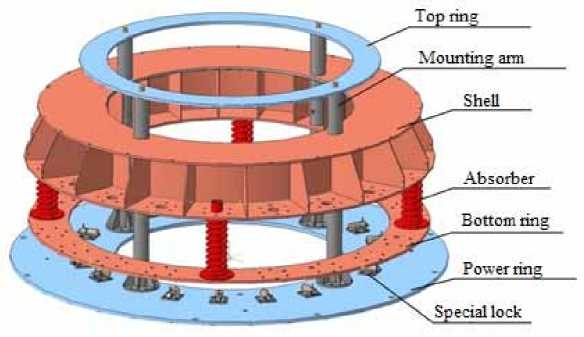
Fig. 1. General view of the main elements of the copra-spring stand
Рис. 1. Общий вид основных исполнительных элементов копрово-пружинного стенда
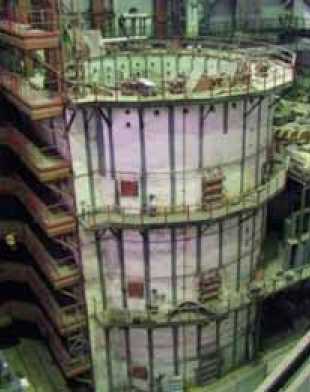
Fig. 2. General view of the pneumatic hydro box RM-2
Рис. 2. Общий вид пневмогидробокса РМ-2
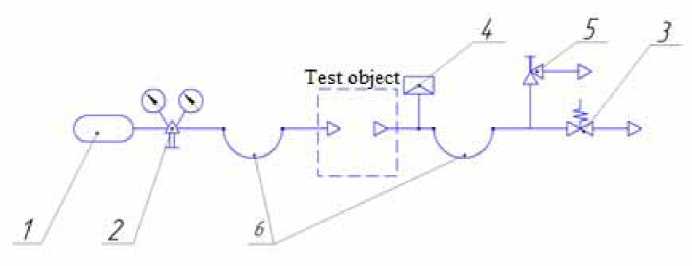
Fig. 3. Internal pressure loading system:
1 – pressure source (balloon etc.); 2 – balloon reducer; 3 – manual adjustable safety valve; 4 – pressure meter; 5 – adjustable manual faucet; 6 – flexible sleeves
Рис. 3. Система нагружения внутренним давлением:
1 – источник давления (баллон, рампа, моноблок и т. п.); 2 – редуктор баллонный;
3 – клапан предохранительный регулируемый ручной; 4 – датчик давления; 5 – вентиль ручной регулируемый; 6 – гибкие рукава
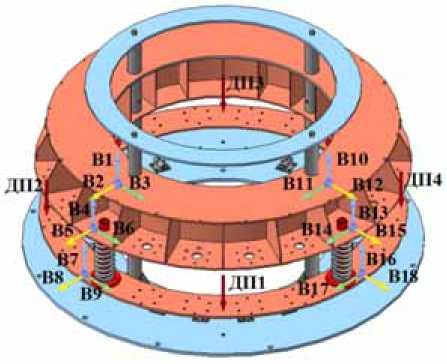
Fig. 4. Layout of primary transducers: ДП1…ДП4 – Motion sensors; В1…В18 – accelerometers
Рис. 4. Схема размещения первичных преобразователей: ДП1…ДП4 – датчики перемещения; В1…В18 – акселерометры

Fig. 5. Raw results from the sensors В4, В13. Drop from the height of 20 mm
Рис. 5. Необработанные результаты с датчиков В4, В13. Сброс с высоты 20 мм
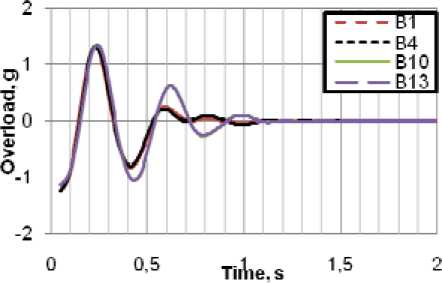
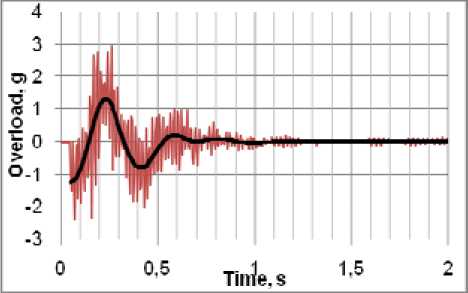
Fig. 6. Comparison of low-frequency components of basic overloads for various parameters ( left ). Comparison of the original and filtered process ( right ). Drop from the height of 20 mm
Рис. 6. Сравнение НЧ-составляющих записей осевых перегрузок по различным параметрам ( слева ) и сравнение исходного и фильтрованного процесса ( справа ) при сбросе с 20 мм
The high-frequency component of the overload data records is related to the self-oscillation excitation of the stand parts. At this stage the stand vibrations at the main longitudinal frequency arouse great interest. Therefore, the data on overloads were filtered out with a low-pass filter without a phase change using the Matlab software. Within the low-frequency range of axial overloads the parameters located in the same vertical plane do not differ (fig. 6, left ), that is why non-coplanar sensors B4 and B13 were chosen for further study. The differences of these sensors readings are due to the presence of an additional component from the transverse oscillations of the stand envelope at frequencies close to the fundamental frequency of the longitudinal vibrations.
In fig. 6 ( right ) the comparison of raw and filtered signals for the sensor B4 when dropped from the height of 20 mm is shown. A similar pattern may be observed in other tests.
Along with the readings of the overloads sensors, when analyzing the results, an assessment was made of overloads levels based on the video of the stand envelope displacement with a frame rate of 120 fps.
To determine the position of the stand envelope special software was developed. The essence of the software was to determine the coordinate of the color transition boundary by the height of the frame from light to darker colour using averaging in rows. To break video record into the frames and cut pieces from frames the open program “ffmpeg” was used. For verification of the developed software manual frame-by-frame measurement of the stand envelope coordinates from time to time was made for one of the experiments.
It turned out that the developed method allows to determine the displacement of the stand mobile part with good accuracy. Thus, the obtained video data may be used for interpretation as well. The further video recordings were processed with the use of the open library PIL (Python Imaging Library). The obtained records of displacement were smoothed out with a low-frequency filter without the phase displacement in order to eliminate interference of records errors and cutting inaccuracies. Axial overloads were calculated by double differentiation of displacement records over time.
A comparison of overloads obtained in various methods when the stand mobile part was dropped from the height of 35 mm is shown in fig. 7. Zero points in time were defined so that the acceleration peaks coincided.
The comparison of overload levels in parameter B4 for a series of three drops from the height of 35 mm is shown in fig. 8. As the figure shows these overload levels are in good agreement.
According to the research tests, the finite element model of the stand was developed and validated under MCS Nastran [14; 15] (fig. 9).
The copra-spring stand structure is a threedimensional mechanical system of complex design-layout scheme whose parts possess essentially different bending and dissipative characteristics. The finite element method was used for calculation. This calculation was carried out in a nonlinear formulation which made it possible to correctly take into account the stand loading at all the stages using the direct integration method of the equations of motion.
In order to simulate the inelastic nature of the mobile and stationary parts collision at the contact position, an additional force is applied to the central assembly on the stand lower part. The magnitude of the force is chosen in such a way as to avoid reverse movement of the mobile part.
The calculation was carried out using the direct integration method of the equations of motion. The damping parameters were set in such a way that the calculated values of the accelerations corresponded best to the measured ones. As a result, the time dependences of displacements and overloads at the sensor installation sites were determined, and a comparison was made with the experimental results.
In fig. 10 a comparison of experimental (recorded and obtained by video processing) and calculated overloads at the sensor B4 installation site is shown. All the data is given after the low-frequency filtration.
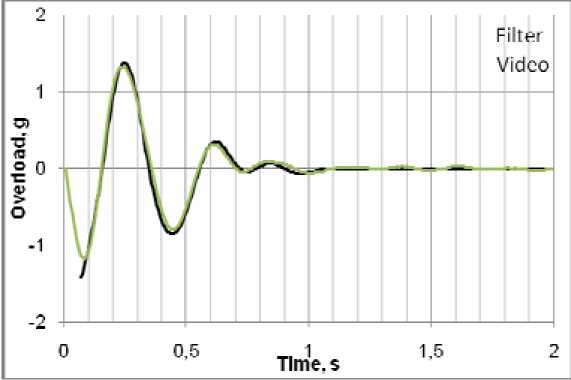
Fig. 7. Comparison of data with accelerometer and video. Drop from the height of 35 mm
Рис. 7. Сравнение данных с акселерометра и видео при сбросе с высоты 35 мм

Fig. 8. Overload comparison. Drop from the height of 35 mm
Рис. 8. Сравнение перегрузок при сбросах с высоты 35 мм
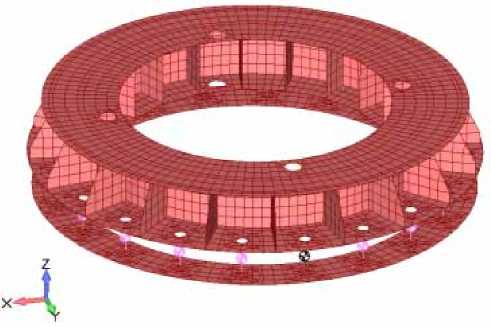
Fig. 9. Finite element model of the movable part of the copra-spring stand
Рис. 9. Конечноэлементная модель подвижной части копрово-пружинного стенда

Fig. 10. Comparison of calculated and experimental overloads. Drop from the height of 20 mm ( left ) and drop form the height 50 mm ( right ). High-frequency components in dependencies are deleted
Рис. 10. Сравнение расчетных и экспериментальных перегрузок при сбросе ОИ с высоты 20 мм ( слева ) и 50 мм ( справа ). ВЧ-составляющие в зависимостях убраны
As the fig. 10 shows it was possible to achieve good agreement between the calculated and experimental data at the fundamental frequency of the stand longitudinal vibrations (~3 Hz for the used set of springs).
The high-frequency component in the overloads records (see fig. 5) is due to the bending vibrations of the stand envelope at the frequency of ~ 55 Hz (53.6 Hz and 55.2 Hz in the calculation model). Such a coincidence of the calculated and experimental tones additionally indicates the correctness of the developed model. It should be noted that this frequency may vary significantly depending on the test object and equipment used.
Conclusion. Thus, according to the results of the conducted research tests, it was possible to achieve a good agreement between the calculated and experimental data on overloads at the main frequency of the stand longitudinal vibrations. The developed model may be used to determine the test conditions and loads evaluation of the test object. Before testing, it is recommended to conduct a series of drops without the test object for additional validation of the stand finite element model.
Список литературы An approach to ground testing of rockets and space vehicles on transient processes by copra-spring stand
- Soyuz User’s Manual, Iss. 2, Revision 0. March 2012, Arianespace.
- Proton Launch System Mission Planner’s Guide, LKEB-9812-1990, Iss. 1, Revision 7, 2009.
- Основы отработки прочности ракетно-космических конструкций / А. В. Кармишин, А. И. Лиходед, Н. Г. Паничкин [и др.]. М.: Машиностроение, 2007. 471 с.
- Беляев И. Т., Зернов И. А. Технология сборки и испытаний космических аппаратов. М.: Машино- строение, 1990. 352 c.
- Методологические основы научных исследований при обосновании направлений космической деятельности, облика перспективных космических комплексов и систем их научно-технического сопровождения. Т. 5. Методология исследований прочности и динамики ракет-носителей и космических аппаратов / А. В. Анисимов, В. С. Асатурьян, Ю. Г. Балакирев [и др.]. М.: Дашков и К, 2016. 376 с.

